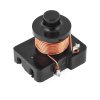I'm new here, but hoping I may get some help.
I am a retired refrigeration and air conditioning technician and I have a project where I need to keep the motor current of a sealed unit compressor between about 5.5 and 6 amps for efficiency while the system is running.
There is a cooling pump I want to switch 'on' when the sealed unit current approaches 6A, and turn it off again when the current falls to about 5.5A. I'll actually be happy with any set-points between 5A and 6A.
My poor old brain keeps telling me there must be a simple way to do this, but I can find nothing commercially available to do the job. There are countless over-current devices which will switch at a set point, but these all seem to be manual reset.
Operating voltage and/or output capacity of any device are somewhat irrelevant, as I can use a transformer to get the required voltage and an output relay to get the needed switching capacity.
Any assistance would be appreciated. Thanks.
I am a retired refrigeration and air conditioning technician and I have a project where I need to keep the motor current of a sealed unit compressor between about 5.5 and 6 amps for efficiency while the system is running.
There is a cooling pump I want to switch 'on' when the sealed unit current approaches 6A, and turn it off again when the current falls to about 5.5A. I'll actually be happy with any set-points between 5A and 6A.
My poor old brain keeps telling me there must be a simple way to do this, but I can find nothing commercially available to do the job. There are countless over-current devices which will switch at a set point, but these all seem to be manual reset.
Operating voltage and/or output capacity of any device are somewhat irrelevant, as I can use a transformer to get the required voltage and an output relay to get the needed switching capacity.
Any assistance would be appreciated. Thanks.


